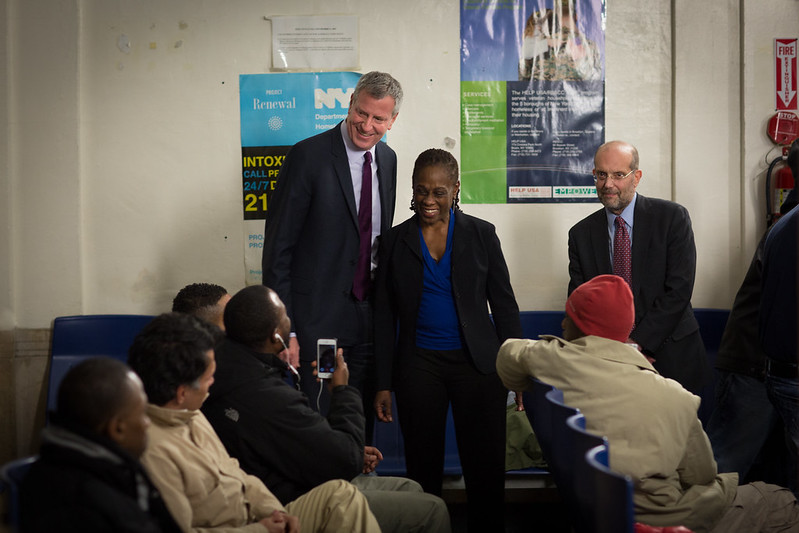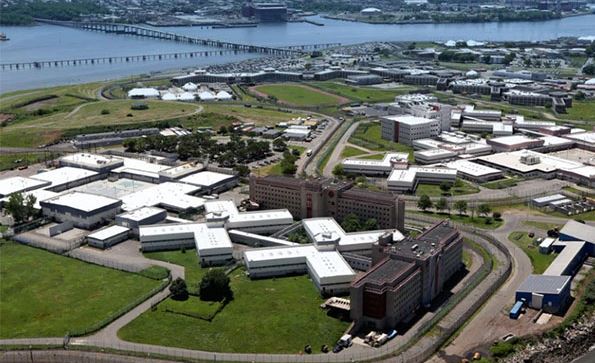Two Troubling Trends Collide in City Homeless Outsourcing

(photo: Michael Appleton/Mayor's Office)
Last week the City of Newark sued New York City over New York’s placement of more than a thousand homeless individuals and families in Newark, through the city’s Special One Time Assistance (SOTA) program. Under the program, New York City employed private brokers to find homes for the families in New Jersey and elsewhere, and, without checking to see if the homes were habitable, paid a full year’s rent in advance and left families to live there. The result was thousands of families sent out of the city into homes that were uninhabitable.
The Newark lawsuit, which details instances of lack of heat and vermin infestations, sought to prevent New York from “coercively relocating” any future families via the SOTA program. Newark’s brief goes on to object to New York’s “ill-conceived, surreptitious efforts to shift the burdens associated with the homeless to other communities in this nation.” In court on Monday, New York agreed to a temporary halt to the program in Newark, but the lawsuit continues.
The SOTA program represents the culmination and convergence of two particularly disturbing recent trends: New York’s failure to provide safe housing for homeless people and New York’s propensity to outsource social services without proper oversight.
As to the first trend, New York City’s recent history in providing unsafe housing for homeless people is distressing. During our time running New York City’s Department of Investigation we did two Reports outlining the deplorable conditions at New York City shelters. Those Reports detailed fire and safety hazards, dead vermin in bedrooms, widespread prostitution activity, and a lack of essential services.
The second, equally disturbing trend, is New York’s continued outsourcing of government programs without proper oversight. While at DOI we witnessed the tendency of New York City agencies to hire private vendors to provide essential services yet fail to: one, set standards for the work to be done; two, supervise the agencies; and three, take action against contractors who neglected to carry out their requisite functions.
For example, one DOI investigation found that while the city’s Administration for Children’s Services hired private providers to carry out certain ACS functions, ACS failed to take action even after learning that some of these providers were not performing up to standards and were putting children in harm’s way. Indeed, ACS continued to pay these providers for dangerously inadequate care.
Similarly, for years, the City’s Department of Correction hired a private company, Corizon Health, to provide health care services to inmates in city jails. Corizon neglected to screen and manage staff, creating a series of dangers without effective oversight from the city. A report from DOI that exposed the problem finally forced the city to remove Corizon.
City government’s mishandling of SOTA combines both trends with the worst possible outcomes. Not only did the city outsource its problem – hiring private brokers to find apartments – but by sending the families to other jurisdictions, and refusing to provide those jurisdictions with the identities and locations of the families, they made oversight impossible.
In theory, getting homeless families housing in New Jersey, where rents are cheaper, is not inherently wrong (regardless of whether the motivation is to get families off New York City’s rolls or some other greater good). But doing this without checking to make sure the housing is habitable and refusing to tell the New Jersey localities who has been placed in their jurisdiction, is unacceptable. Only the filing of a lawsuit forced New York to provide Newark with information on the families’ locations.
This goes beyond a failure to set standards and supervise outside contractors. Here, when New York sent these families to Newark and paid the private landlords for a year in advance, New York gave up the ability to have its own agencies make sure the housing was habitable and it failed to give New Jersey that opportunity. The end result was that New York had less money -- having sent it to landlords who provided deplorable housing -- and Newark, not aware of where the placements were, was unable to fix the problem.
Going forward, if New York is to continue sending homeless families out of state – and, it appears that it plans to do so – at a minimum the city must properly check the habitability of all dwellings, stop paying for a full year in advance, and coordinate with the other jurisdictions, providing them full information and cooperation. Anything less is not an anti-homelessness program but a dumping of responsibilities.
***
Peters and Brovner are the founding partners of the law firm Peters Brovner LLP and were, respectively, the Commissioner and First Deputy Commissioner of the New York City Department of Investigation from 2014 to 2018.
***
Have an op-ed idea or submission for Gotham Gazette? Email This email address is being protected from spambots. You need JavaScript enabled to view it.
For Future Generations, New York City and State Must Significantly Increase CUNY Investment Now

(photo: John McCarten/City Council)
I’m a CUNY graduate twice over – my bachelor’s and master’s degrees are both from Brooklyn College. Between the seven years I took for my four-year degree, and the four years for my two-year degree, I’ve spent about as much time on a CUNY campus as anyone. My professors, my fellow students, my overall CUNY experience shaped who I am and what my driving principles are -- what I’ve been fighting for as an activist and an elected official.
Now, as tuition rises and investment stagnates, I fear that students across our city will be denied that transformative, invaluable, CUNY experience.
As outlined in my recent report, government funding for CUNY has failed to keep up with booming enrollment. From 2008 to 2017, per-student funding from the state dropped 18 percent, adjusted for inflation and enrollment growth. This continued underfunding has hamstrung CUNY’s ability to provide a quality education for thousands of students, most of whom are people or more color and graduated from our city’s public schools.
In fact, the student body of CUNY appears directly related to its funding. When CUNY was first established, it was tuition-free, in recognition of the need for accessible, high-quality public education. But as the complexion of CUNY students changed, so too did the policy, with black and brown student majorities made to bear the brunt of the expense as the balance of funding CUNY shifted away from government and toward the student population. This has naturally also contributed to the overall challenges of financing this “public” education.
With limited resources, CUNY has seen its operational quality threatened as the system has to rely on underpaid adjunct faculty to teach its students, many of whom work additional jobs to pay their bills. CUNY has also been forced to cut student support services—like academic and mental health advisors or hours at writing centers—and course selections, leaving many students unable to register for a mandatory class.
Financial shortcomings are also evident in CUNY’s physical infrastructure—broken toilets, exposed wiring, vermin outbreaks, flooding, and broken elevators further detract from the educational experience of today’s students.
Unfortunately, the students who suffer the most from underfunding are those who most need our help. CUNY’s constrained budget provides limited opportunity for it to help support its most vulnerable students, many of whom are food insecure, homeless, or come from low-income families. While tuition remains comparatively low, CUNY students who receive tuition assistance still must pay for major expenses like housing and food, forcing them to work for pay and spend more time away from their studies. Without proper support, CUNY students are finding it hard to graduate.
However, there’s a silver lining: CUNY knows what works and just needs the resources to do it.
CUNY has created innovative programming, like ACE and ASAP, which have already boosted graduation rates and improved educational outcomes. Other programs aimed at providing support for specific marginalized communities, including the Black Male Initiative and Citizenship! Now, help campuses retain and support students of more color, who make up the majority of CUNY’s population.
These programs and others are part of why CUNY campuses are among the best nationwide for raising the economic statuses of the system’s most vulnerable students—a pathway and an opportunity for lower- and middle-class students of all racial and ethnic backgrounds. It’s also critical to know when something doesn’t work, like the Excelsior Scholarship, which made headlines but not real change, as nowhere near enough students saw relief from ever-escalating costs of a college education.
To ensure CUNY can support its mission of serving as a vehicle of social mobility that provides quality education for all New Yorkers, New York State and New York City must increase investment in public higher education. Crucially, the city must specifically increase its funding for CUNY senior colleges, which have historically received limited city funding, to better match their contribution to our city’s economy and culture.
This month, CUNY’s staff and faculty union, the Professional Staff Congress (PSC), ratified a new contract that secured historic gains for nearly 30,000 workers. But any discussion of increasing wages must be coupled with calls to address the underlying issue: the need for New York to increase its financial commitment to public higher education.
Our state and city leaders are now at a critical juncture. They can either decide to build on their investment in higher ed and ensure students receive a quality affordable education, or allow an invaluable, historic educational institution to decline, along with the opportunities it creates.
With greater funding, CUNY will be able to increase the percentage of its faculty that works full-time and raise salaries for remaining adjuncts. It can also expand its student tuition-assistance programs to include more part-time students and even currently incarcerated individuals. And it can continue to build on its world-class programming, providing an invaluable education for generations of New Yorkers like it did for me and so many others already.
***
Jumaane Williams is the Public Advocate of the City of New York. On Twitter @JumaaneWilliams.
***
Have an op-ed idea or submission for Gotham Gazette? Email This email address is being protected from spambots. You need JavaScript enabled to view it.
The Energy Behind the Renewable Rikers Vision

Rikers Island (photo via Lippman Commission report)
After five years of struggle, the New York City Council voted last month to finally shutter the house of horrors that is Rikers Island. Closing this facility, however, is only the first step toward true restorative justice. New York City must invest in the communities that have borne the brunt of the over-policing and under-investment that fueled the mass incarceration machine. These communities are the same ones who are most vulnerable to rising sea levels, toxic air, and extreme heat brought about by the climate crisis.
The good news is that a group of advocates, experts, community organizations, and Council members has proposed a solution to solving all of these challenges with one sound policy: a Renewable Rikers Island.
Our collaboration created a framework for the Renewable Rikers Act, a three-bill package that sets us down a road to restorative justice. The plan would mean fewer trucks, cleaner air, less waste, lower asthma rates, and new access to waterfront and affordable housing on the footprint of former pollution factories.
The Lippman Commission on the closure of the Rikers jails, the #CloseRikers coalition, and the City Council’s Progressive Caucus have all endorsed this as the best plan moving forward.
We can use part of what will be newly-available 413 acres to build a solar farm, with space for large-scale batteries to store the energy generated. With plenty of land left over, the city can build a state-of-the-art wastewater treatment plant on Rikers to absorb much of the sewage overflow that currently pollutes our waterways, particularly adjacent to low-income and working communities. If the ambitious vision is implemented, this new waste water treatment plant could mean shutting down one or more of the Depression-era wastewater treatment plants in communities overrun with polluting facilities.
A new treatment plant on Rikers should also be outfitted with an anaerobic digester, which turns the facility’s sludge into natural gas. This digester can also process food waste that currently goes to a landfill, where it emits greenhouse gases. Expanding organic waste processing on Rikers means it will no longer be trucked in and out of the South Bronx, North Brooklyn, Southeast Queens, and Sunset Park, where most waste transfer stations are clustered.
Even if we make only some of this happen on Rikers Island, it would open up land in communities of color that have been disproportionately impacted by the criminal justice system. The Regional Plan Association expects more than 200 acres of city-owned land to become available for public use if we build wastewater plants on Rikers. Closing “peaker” plants – the plants that only kick on during times of high power demand – across the five boroughs will open up sizeable footprints in communities of color that have long pined for new parks, community centers, and affordable housing, while also reducing the air pollution emitted by these fossil-fuel burning plants.
And finally, a Renewable Rikers will create thousands of good, green jobs in innovative industries. Those should be filled primarily by the formerly incarcerated who have turned their lives around, as well as members of communities who for too long saw little investments in their neighborhoods.
We can only have real environmental justice if the stakeholders in these neighborhoods are the ones who drive the conversation around how this land is used. The time to listen to their voices is now.
Detractors and distractors will try to point to other possibilities for Rikers Island, but we believe that is simply an attempt to kick the can down the road. Justice delayed is justice denied. Any proposal that does not directly benefit the communities so long impacted by the abhorrent conditions in the jails on Rikers should not be considered as a matter of process and justice. And, this land is unsuitable for anything else because it is built on a decaying toxic landfill.
The coalition of criminal justice reform, community, environmental, faith-based, and environmental justice organizations and advocacy groups who support the Renewable Rikers vision is diverse and vast. This is a clear opportunity for our city to continue taking bold and progressive steps towards a more sustainable and just future, and passing the Renewable Rikers Act is the first critical measure to ensure we move toward this vision of a cleaner, greener, fairer city.
***
City Council Member Costa Constantinides represents parts of Queens and Rikers Island, and chairs the Council’s Committee on Environmental Protection; he’s on Twitter @Costa4NY. Melissa Iachan, Esq., is a Senior Staff Attorney in the Environmental Justice Program at New York Lawyers for the Public Interest.
***
Have an op-ed idea or submission for Gotham Gazette? Email This email address is being protected from spambots. You need JavaScript enabled to view it.




